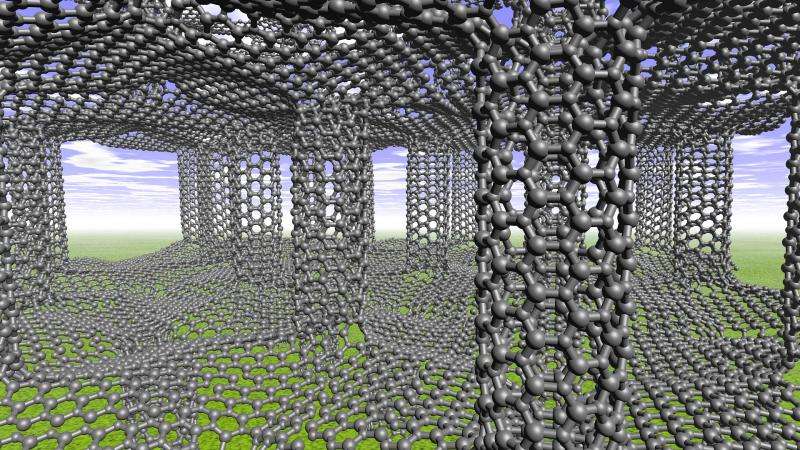Researchers model graphene/nanotube hybrids to test properties

Rice University researchers discovered that putting nanotube pillars between sheets of graphene could create hybrid structures with a unique balance of strength, toughness and ductility throughout all three dimensions.
Carbon nanomaterials are common now as flat sheets, nanotubes and spheres, and they're being eyed for use as building blocks in hybrid structures with unique properties for electronics, heat transport and strength. The Rice team is laying a theoretical foundation for such structures by analyzing how the blocks' junctions influence the properties of the desired materials.
Rice materials scientist Rouzbeh Shahsavari and alumnus Navid Sakhavand calculated how various links, particularly between carbon nanotubes and graphene, would affect the final hybrid's properties in all directions. They found that introducing junctions would add extra flexibility while maintaining almost the same strength when compared with materials made of layered graphene.
Their results appear this week in the journal Carbon.
Carbon nanotubes are rolled-up arrays of perfect hexagons of atoms; graphene is a rolled-out sheet of the same. Both are super-strong and excel at transmitting electrons and heat. But when the two are joined, the way the atoms are arranged can influence all those properties.
"Some labs are actively trying to make these materials or measure properties like the strength of single nanotubes and graphene sheets," Shahsavari said. "But we want to see what happens and quantitatively predict the properties of hybrid versions of graphene and nanotubes. These hybrid structures impart new properties and functionality that are absent in their parent structures—graphene and nanotubes."
To that end, the lab assembled three-dimensional computer models of "pillared graphene nanostructures," akin to the boron-nitride structures modeled in a previous study to analyze heat transfer between layers.
"This time we were interested in a comprehensive understanding of the elastic and inelastic properties of 3-D carbon materials to test their mechanical strength and deformation mechanisms," Shahsavari said. "We compared our 3-D hybrid structures with the properties of 2-D stacked graphene sheets and 1-D carbon nanotubes."
Layered sheets of graphene keep their properties in-plane, but exhibit little stiffness or thermal conductance from sheet to sheet, he said. But pillared graphene models showed far better strength and stiffness and a 42 percent improvement in out-of-plane ductility, the ability to deform under stress without breaking. The latter allows pillared graphene to exhibit remarkable toughness along out-of-plane directions, a feature that is not possible in 2-D stacked graphene sheets or 1-D carbon nanotubes, Shahsavari said.
The researchers calculated how the atoms' inherent energies force hexagons to take on or lose atoms to neighboring rings, depending on how they join with their neighbors. By forcing five, seven or even eight-atom rings, they found they could gain a measure of control over the hybrid's mechanical properties. Turning the nanotubes in a way that forced wrinkles in the graphene sheets added further flexibility and shear compliance, Shahsavari said.
When the material did fracture, the researchers found it far more likely for this to happen at the eight-member rings, where much of the strain gathers when stressed. That leads to the notion the hybrids can be tuned to fail under particular circumstances.
"This is the first time anyone has created such a comprehensive atomistic 'lens' to look at the junction-mediated properties of 3-D carbon nanomaterials," Shahsavari said. "We believe the principles can be applied to other low-dimensional materials such as boron nitride and molybdenum/tungsten or the combinations thereof."
Shahsavari is an assistant professor of civil and environmental engineering and of materials science and nanoengineering at Rice.
More information: "Junction configuration-induced mechanisms govern elastic and inelastic deformations in hybrid carbon nanomaterials," Carbon, Volume 95, December 2015, Pages 699-709, ISSN 0008-6223, dx.doi.org/10.1016/j.carbon.2015.08.106
Journal information: Carbon
Provided by Rice University



















